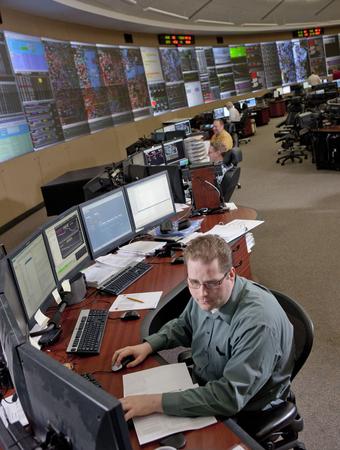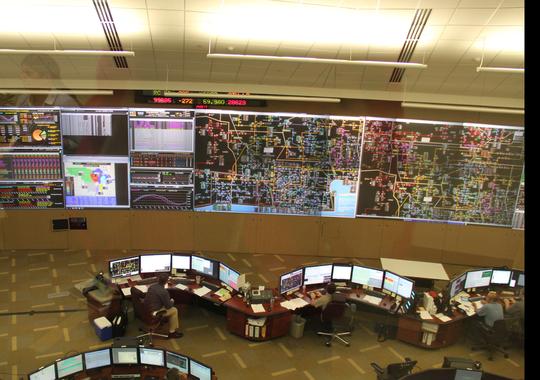Midwest power grid overseer has learned lessons
CARMEL, Ind. — A decade after it shared part of the blame for the biggest blackout in U.S. history, a regional power system administrator based here has upgraded its technologies[1] and enjoys more control over an array of high-voltage power lines in 15 states.
STORY: U.S. grid faces new threats
2008: Power grid in better shape 5 years later[2][3]
More eyeballs are scanning more "data points" than ever before — taking real-time measurements of power needs and surges at about 250,000 points along 65,250 miles of power lines — giving the operations center for the not-for-profit Midwest Independent Transmission System Operator (MISO) much better chance of preventing the kind of blackout that left 50 million people in the dark on Aug. 14, 2003.
But is that enough to guarantee power won't ever zap out again across eight states and parts of Canada, the way it did that day?
"There is never enough safeguards to completely prevent it from happening again," said Joe Gardner, vice president of forward markets and operations for MISO. "We could have multiple things happen at the same time. That could cause an issue. ... Several transmission lines could all trip at the same time, and that's not something we are able to prepare for."
But with new technologies giving screen-watchers real-time measurements and constantly updated information every 4 minutes about more than 11,000 "what-if" scenarios, the odds are significantly better that a major incident can be isolated and contained, company officials said.
"They can do what-ifs, contingencies, what happens if I lose this generator, this line or this transformer," said David Zwergel, senior director of regional operations at MISO. "They can use that tool to monitor closely an area, talk to the local transmission operators.
"And as they approach limits, they will take action to make sure they don't exceed that limit."
That's one of the biggest changes from 2003, when MISO did not enjoy consistent real-time technology and had no ability or authority to make the kind of single decision that could have prevented a major blackout. Such solutions back then would have had to be coordinated through nearly two dozen individual power authorities — with precious few minutes to get that done.
Today, that kind of action can be "forced" within the MISO market, which, thanks to a new expansion into the South, will soon span from New Orleans to Manitoba, Michigan to Montana.

Analysts monitor the power grid at MISO headquarters in Indiana.(Photo: MISO)
"We can be solving problems and finding solutions every few minutes," Zwergel said.
2003: Blackout experts struggle to shed light[4]
In the past 10 years, MISO's upgrades mirror what has transpired across the U.S. as the industry addressed the 2003 blackout, which was ultimately blamed on a tree branch in Ohio that touched a power line and set off outages that cascaded across Ohio, Pennsylvania, New York and several East Coast cities.
Millions were without lights and air conditioning for several hours, some for days in what grew into the largest blackout in North American history.
Less than a year after the incident, a federal commission issued its final report on the 2003 blackout, holding First Energy in Northeast Ohio primarily responsible and MISO partially responsible because it did not have real-time data of the event, causing it to fail in grasping the scope of the problem and alerting its power company members.
When the tree branch came in contact with the power line near Cleveland, grid operators didn't initially realize what was happening.
Shortly after 3 p.m., First Energy lost three high-voltage lines, and operators did not realize what was happening because earlier that day, First Energy's alarm system had crashed. As each line began to fail, the load increased on other lines, causing them to fail.
And at 4:05 p.m., a small blackout in Ohio grew into a national story when power lines began to fail across the power grid serving the Northeast and parts of Canada. It took just five more minutes for 263 power plants to shut down from New York to Pennsylvania, Vermont to Ontario and around the Great Lakes.
Two small plants in Indiana also shut down for a short time, but Indiana did not experience massive blackouts.
“We need to make the grid smaller to minimize the risks posed by a systemwide blackout.”
— Kerwin Olson, consumer advocateToday, MISO no longer serves as a reliability coordinator for First Energy, which a few years later joined a different network of coordination, Pennsylvania New Jersey Maryland (PJM) Interconnection, headquartered in Valley Forge, Pa.
Not everyone agrees the changes in the past decade have been the best response. Executive Director Kerwin Olson of the Citizens Action Coalition believes the nation needs to think smaller when it comes to preventing blackouts.
"The best investments we can make to protect against a blackout is move aggressively towards distributed energy and customer-owned, on-site generation," said Olson, a consumer advocate. "We need to rapidly deploy micro-grids, rooftop (photovoltaic power) and other sources of clean energy.
"We need to make the grid smaller to minimize the risks posed by a systemwide blackout. The closer to the end user the energy generation source is, the less risk."
Olson calls the current massive power grid system "inefficient, dirty and ripe for blackouts, complications and cyberattacks."
But a recent report from North American Electric Reliability Corp., which sets standards and tracks the performance of power plants and high-voltage transmission lines, says the grid's reliability is high, according to The Associated Press.
Last year was particularly good. Not including extreme weather events, major transmission lines caused power losses only twice in 2012, after averaging nine instances annually from 2008 to 2011.
Most outages stem not from the bulk system but from smaller failures in distribution systems managed by local utilities and regulated by states. Not including storm-related outages, the average U.S. customer goes without power 1.2 times annually for a total of 112 minutes, according to PA Consulting Group.
Source: MISO-PJM Joint and Common Market[5]
About MISO
Once known as Midwest ISO, this nonprofit, member-based organization monitors the system that delivers power from generating plants to wholesale power transmitters, which deliver power to distribution companies, which, in turn, send power to homes and businesses.
• Control centers: Carmel, Ind., headquarters; St. Paul, Minn., regional office.
• History: Midwest ISO was founded in 1996. ISOs (independent system operators) act like traffic police, adjusting the flow of electricity and making sure power lines don't get overloaded.
• Employees: 857
• Transmission lines: 65,250 miles of high-voltage power lines in parts of 14 states and one Canadian province

Inside the control room where Carmel, Ind.-based MISO monitors a massive power grid stretching across 14 states, one Canadian province and more than 65,000 miles of high voltage lines.(Photo: MISO)
References
- ^ a regional power system administrator based here has upgraded its technologies (www.indystar.com)
- ^ http://www.usatoday.com/story/news/nation/2013/08/09/blackout-us-grid/2636339/ (www.usatoday.com)
- ^ http://usatoday30.usatoday.com/money/industries/energy/2008-08-12-blackout-power-outage_N.htm (usatoday30.usatoday.com)
- ^ http://usatoday30.usatoday.com/money/industries/energy/2003-10-12-cover-blackout_x.htm (usatoday30.usatoday.com)
- ^ http://www.miso-pjm.com/ (www.miso-pjm.com)









